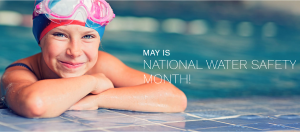
While May is officially National Water Safety Month, it’s important to be water aware year-round. Swimming is one of life’s great pleasures. It offers many health and fitness benefits, cools you off in the summer, and provides a great opportunity to socialize with family and friends. Make sure you and yours stay safe in the water by being water aware. Follow these safety tips from the World Waterpark Association:
- Learn to swim: Swimming Lesson Save Lives.™ The best thing anyone can do to stay safe in and around the water is to learn to swim. This includes both adults and children. Note: The American Academy of Pediatrics now supports swimming classes after the age of 1 if the child is emotionally and developmentally ready.
- Never leave children unattended: Parents are the first line of defense in keeping kids safe in the water. Never leave children unattended near water, not even for a minute. If your child’s in the water, you should be too! Constant, careful supervision and barriers such as pool fencing are necessary even when children have completed swimming classes.
- Wear a life jacket: If you or a family member is a weak or non-swimmer, wear a life vest. It’s nothing to be embarrassed about and many facilities provide them at no charge.
- Read all posted signs: Follow posted safety rules and warnings. Teach kids that being safe in and around the water is a personal responsibility – yours and theirs.
- Never swim alone or in unsupervised places: Teach your children to always swim with a buddy.
- Look for lifeguards: It is always best to swim in an area supervised by lifeguards, but remember, lifeguards are the last line of defense when all other layers of protection fail.
- Don’t drink alcohol: Avoid alcoholic beverages before or during swimming, boating or engaging in other water-related activities. Never drink alcohol while supervising children around water. Teach teenagers about the danger of drinking alcohol while swimming or boating.
- Spit it out: Teach kids not to drink the pool water. To prevent choking, never chew gum or eat while swimming, diving or playing in water.
- Avoid water wings: Do not use air-filled swimming aids (such as “water wings”) in place of life jackets or life preservers with children. Using air-filled swimming aids can give parents and children a false sense of security. These air-filled aids are toys and are not designed to be personal-flotation devices.
- Watch out for the dangerous “too’s”: Don’t get too tired, too cold, too far from safety, exposed to too much sun or experience too much strenuous activity. Don’t take chances by overestimating your swimming skills.
- Note the weather: Pay attention to local weather conditions and forecasts. Stop swimming at the first indication of bad weather.
- Use sunscreen: Apply sunscreen on all exposed skin to ensure maximum skin protection. Hats, visors and shirts are recommended to prevent overexposure.
- Keep toddlers in shallow play areas: Zero-depth entry pools have water games, sprays and fountains with no appreciable water depth.
- Follow age & Height instructions as well as health restrictions: Restrictions apply to many rides and attractions at pools and waterparks. Size and coordination is critical to safety inside open water flumes. Guests with neck or back problems, heart conditions, prevalence toward motion sickness or pregnancy should not ride high-speed or rapid-descent rides.
- Use plastic swim diapers: Many parks require them. Note where changing areas are located and use these designated, sanitized changing spots.
National Water Safety Month is an annual awareness campaign coordinated by the Pool & Hot Tub Alliance with support from the American Red Cross, National Recreation and Park Association and World Waterpark Association. For more information go to https://nwsm.phta.org/.

